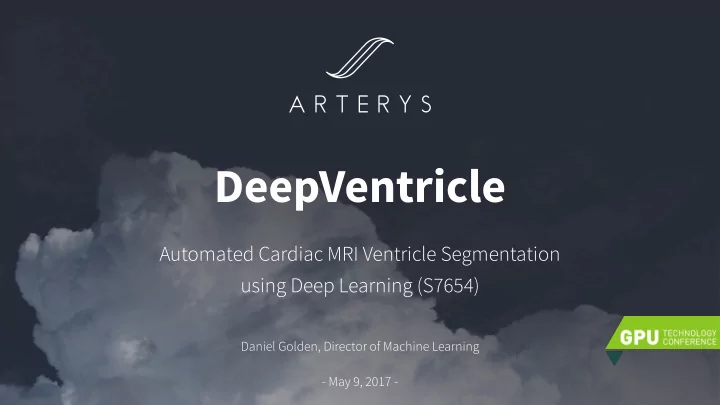

DeepVentricle Automated Cardiac MRI Ventricle Segmentation using Deep Learning (S7654) Daniel Golden, Director of Machine Learning - May 9, 2017 -
Background 5.7M US adults have heart failure Reduced cardiac function Ejection Fraction (EF): Fraction of blood ejected from heart in one cardiac cycle Healthy EF: 55–70% Goal: help clinicians make timely and accurate diagnosis of heart failure
From Area to Volume Manual EF measurements take ~30+ minutes. Goal: automate contouring
Dataset Steady-state free precession imaging (SSFP) RV Endo LV Endo ~1000 de-identified studies 3 types of ground truth contours: Le fu ventricle endocardium (blood pool) • LV Epi Le fu ventricle epicardium (blood pool + • myocardium muscle) Right ventricle endocardium (blood pool) •
Missing Data LV Endo RV Endo LV Epi All contours present Missing LV epi Missing LV endo and LV epi
Missing Data Percentage of all images with label LV Endo RV Endo LV Epi All Labels 0% 20% 40% 60% 80% 100%
DeepVentricle Network Architecture 3x3 Convolution Max Pooling Usample + Convolution 1x1 Convolution Ronneberger, Olaf, Philipp Fischer, and Thomas Brox. 2015. “U-Net: Convolutional Networks for Biomedical Image Segmentation.” arXiv [cs.CV]. arXiv. http://arxiv.org/abs/1505.04597.
Incorporating Missing Data Prediction Ground truth Cross-entropy Ground truth 0.2 0.4 Final = 0.3
E ff ect of missing data Before A fu er (without missing data, 20% of data) (with missing data, all data)
Evaluation on 100-study test set Data • 100 studies, each with a single clinician’s annotation Procedure • Perform inference on each study • Calculate Relative Absolute Volume Error (RAVE) • E.g., if true volume is 100 mL, and we calculate 110 mL, RAVE is abs(110 - 100)/100 = 0.1
Evaluation on 100-study test set Relative Absolute Volume Error (RAVE) ED ES 0.12 0.10 LV Endo 0.08 RV Endo 0.06 0.04 LV Epi 0.02 0.00 LV Endo LV Epi RV Endo
Evaluation on 15-study multi-annotator set Data • 15 studies, each with 7 blinded readers’ annotations Procedure Metrics: Ejection Fraction, Myocardial Mass • Calculate consensus volumes • Calculate standard deviation of readers’ measurements • Perform inference on each study • Calculate error in units of inter-reader standard deviation •
Evaluation on 15-study multi-annotator set Relative Error (Inter-reader Standard Deviations) 1.0 0.8 LV Endo 0.6 RV Endo 0.4 0.2 LV Epi 0.0 LV Ejection Fraction LV Mass
Training Procedure Keras, TensorFlow, AMD GPUs (LOL J/K 😺 ) Original Dev Boxes with Titan X and Google Compute Engine with K80s Real-time data augmentation (cropping, rotation, Augmented images flipping, elastic distortion, shi fu ing and scaling) Hyperparameter optimization with random search
Cardio DL Cardio DL : first ever clinical, cloud-based deep learning so fu ware with FDA clearance (Jan 2017) Full cardiac suite Fully cloud based on AWS, enables continuous learning Inference takes around ~15 seconds for a 300-image study parallelized across four P2 instances
FastVentricle: Cardiac Segmentation with ENet https://arxiv.org/abs/1704.04296
DeepDream-style Model Introspection
Arterys Machine Learning Team Felix Lau Matthieu Le Jesse Lieman-Sifry Sean Sall With support from John Axerio-Cilies (CTO) and Albert Hsiao (Clinical Co-Founder)
Daniel Golden Director of Machine Learning, Arterys dan@arterys.com
15-study set inter-rater variation Avg. st. dev. of ground truth EF: 4.4% (rel: 0.11) Avg. st. dev. of ground truth mass: 18 g (rel: 0.14)
Inter-rater variability LV Endo RV Endo LV Epi Below valve plane Above valve plane Partial segmentation
Hypertrophic cardiomyopathy (Enlargement of heart muscle)
Single ventricle defect
Recommend
More recommend